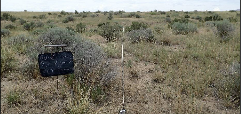From the Rocky Mountain Research Station:
Seeding an area after a fire has long been used to control erosion and suppress problem invasive grasses like cheatgrass. But for managers, choosing the right seed mix to use can be tricky. Seed mixes containing only native species are ideal for areas where natural vegetation recovery is a long-term objective, but there is a question of both cost and whether native species will be as effective as nonnatives in outcompeting invasive species.
Read the original research here.

